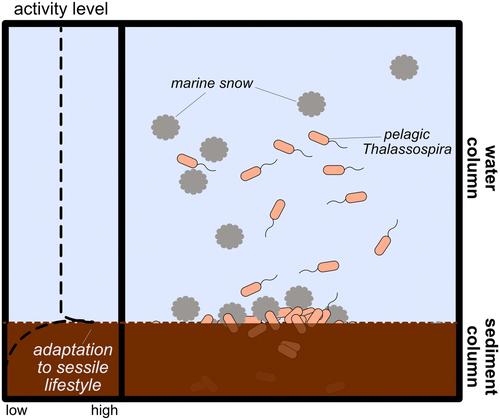当前位置:
X-MOL 学术
›
Environ. Microbiol.
›
论文详情
Our official English website, www.x-mol.net, welcomes your
feedback! (Note: you will need to create a separate account there.)
Genomic stasis over millions of years in subseafloor sediment
Environmental Microbiology ( IF 4.3 ) Pub Date : 2024-08-15 , DOI: 10.1111/1462-2920.16674 Arkadiy I Garber 1 , Gustavo A Ramírez 2 , Steven D'Hondt 3
Environmental Microbiology ( IF 4.3 ) Pub Date : 2024-08-15 , DOI: 10.1111/1462-2920.16674 Arkadiy I Garber 1 , Gustavo A Ramírez 2 , Steven D'Hondt 3
Affiliation

|
One of the significant challenges in microbiology is to understand the extent and mechanisms of evolution within life beneath the surface of the Earth. The population bottleneck that microbes in deep marine sediment experience implies that mutational and population genetic forces could lead to higher levels of relaxed selection and an increase in pseudogenes. To investigate this hypothesis, a group of Thalassospira strains were isolated from subseafloor sediment that is 3 to 6 million years old, as reported by Orsi and colleagues in 2021. These isolates, representing lineages that have been buried for millions of years, offer an excellent opportunity to study the evolution of life beneath the seafloor over a long period. The existence of closely related strains from environments on the surface of the Earth enabled us to examine the impact of selection within each group. We discovered that isolates from beneath the seafloor show lineage‐specific similarities to Thalassospira from the surface world, both in the overall intensity of selection on the genome and in the specific genes affected by mutation. We found no signs of increased relaxed selection or other notable genomic changes in the genomes of the Thalassospira isolates from beneath the seafloor, suggesting that these subseafloor isolates were awakened from a million‐year near‐stasis. The unique genomic characteristics of each Thalassospira lineage from beneath the seafloor must then reflect genetic changes that surface‐inhabiting decendants acquired in the past 3–6 million years. Remarkably, Thalassospira lineages beneath the surface appear to have stably maintained their genomes in the midst of metabolic dormancy and extremely long generation times.
中文翻译:

海底沉积物中数百万年的基因组停滞
微生物学的重大挑战之一是了解地球表面下生命进化的程度和机制。深海沉积物中的微生物经历的种群瓶颈意味着突变和种群遗传力可能导致更高水平的宽松选择和假基因的增加。为了研究这个假设,一组海螺属Orsi 及其同事在 2021 年报告称,这些菌株是从 3 至 6 百万年前的海底沉积物中分离出来的。这些菌株代表了埋藏了数百万年的谱系,为研究海底生命的进化提供了绝佳的机会。海底长期存在。地球表面环境中密切相关的菌株的存在使我们能够检查每个群体内选择的影响。我们发现来自海底以下的分离株表现出谱系特异性的相似性海螺属从表面世界来看,无论是在基因组选择的总体强度上还是在受突变影响的特定基因上。我们没有发现放松选择增加的迹象或基因组中其他显着的基因组变化的迹象。海螺属分离物来自海底下方,表明这些海底分离物是从百万年的近乎停滞中苏醒的。每个个体都有独特的基因组特征海螺属来自海底下面的谱系必须反映过去 3-600 万年生活在地表的后代所获得的基因变化。 值得注意的是,海螺属地表以下的谱系似乎在代谢休眠和极长的世代时间中稳定地维持了其基因组。
更新日期:2024-08-15
中文翻译:

海底沉积物中数百万年的基因组停滞
微生物学的重大挑战之一是了解地球表面下生命进化的程度和机制。深海沉积物中的微生物经历的种群瓶颈意味着突变和种群遗传力可能导致更高水平的宽松选择和假基因的增加。为了研究这个假设,一组海螺属Orsi 及其同事在 2021 年报告称,这些菌株是从 3 至 6 百万年前的海底沉积物中分离出来的。这些菌株代表了埋藏了数百万年的谱系,为研究海底生命的进化提供了绝佳的机会。海底长期存在。地球表面环境中密切相关的菌株的存在使我们能够检查每个群体内选择的影响。我们发现来自海底以下的分离株表现出谱系特异性的相似性海螺属从表面世界来看,无论是在基因组选择的总体强度上还是在受突变影响的特定基因上。我们没有发现放松选择增加的迹象或基因组中其他显着的基因组变化的迹象。海螺属分离物来自海底下方,表明这些海底分离物是从百万年的近乎停滞中苏醒的。每个个体都有独特的基因组特征海螺属来自海底下面的谱系必须反映过去 3-600 万年生活在地表的后代所获得的基因变化。 值得注意的是,海螺属地表以下的谱系似乎在代谢休眠和极长的世代时间中稳定地维持了其基因组。































 京公网安备 11010802027423号
京公网安备 11010802027423号